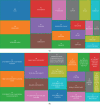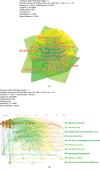Characterizing Hotspots and Frontier Landscapes of Diabetes-Specific Distress from 2000 to 2018: A Bibliometric Study
- PMID: 32016121
- PMCID: PMC6985931
- DOI: 10.1155/2020/8691451
Characterizing Hotspots and Frontier Landscapes of Diabetes-Specific Distress from 2000 to 2018: A Bibliometric Study
Abstract
Objectives: This work aims to comprehensively characterize hotspots and frontier landscapes concerning diabetes-specific distress from 2000 to 2018. Materials and Methods. Firstly, diabetes-specific distress-related literature was retrieved and downloaded from the Web of Science Core Collection (WoSCC). Secondly, WoSCC self-contained toolkits and GraphPad Prism7 were conducted to analyze general characteristics, including literature products, countries, institutes, authors, and journal resource. Finally, CiteSpace V Toolkits was put forward to implement advanced analysis, consisting of keyword-term frequency and co-occurrence, references-cited frequency and co-occurrence, and burst detection for keyword terms and references cited, which uncovers the hotspots and frontiers of diabetes-specific distress.
Results: After preprocessing, our study included a total of 1051 papers concerning diabetes-specific distress. Publication outputs increased smoothly year by year. Compared with other journals, diabetic medicine delivered the largest number of documents. The United States occupied the leading positions, and the most productive institution was the University of California System in terms of literature products. Fisher L. has the highest references-cited frequency. Prevalence of diabetes-specific distress, diabetes-specific distress and glycemic control, diabetes-specific distress and depression comorbidity, and diabetes-specific distress and risk factors were the research hotspots, whereas the measure of diabetes-specific distress and latent and serious/severe diabetes-specific distress was the research frontiers.
Conclusions: Overall, our study may inspire researchers to show great interest in diabetes-specific distress in the next few years.
Copyright © 2020 Dan Li et al.
Conflict of interest statement
The authors declare that they have no conflicts of interest.
Figures







Similar articles
-
Mapping Knowledge Landscapes and Emerging Trends of the Links Between Bone Metabolism and Diabetes Mellitus: A Bibliometric Analysis From 2000 to 2021.Front Public Health. 2022 Jun 3;10:918483. doi: 10.3389/fpubh.2022.918483. eCollection 2022. Front Public Health. 2022. PMID: 35719662 Free PMC article. Review.
-
Bibliometric Analysis of Renal Fibrosis in Diabetic Kidney Disease From 1985 to 2020.Front Public Health. 2022 Feb 4;10:767591. doi: 10.3389/fpubh.2022.767591. eCollection 2022. Front Public Health. 2022. PMID: 35186833 Free PMC article.
-
Global diabetic kidney disease research from 2000 to 2017: A bibliometric analysis.Medicine (Baltimore). 2019 Feb;98(6):e14394. doi: 10.1097/MD.0000000000014394. Medicine (Baltimore). 2019. PMID: 30732183 Free PMC article.
-
Knowledge domain and hotspots analysis concerning applications of two-photon polymerization in biomedical field: A bibliometric and visualized study.Front Bioeng Biotechnol. 2022 Sep 30;10:1030377. doi: 10.3389/fbioe.2022.1030377. eCollection 2022. Front Bioeng Biotechnol. 2022. PMID: 36246385 Free PMC article.
-
Global Trends and Research Hotspots of Exercise for Intervening Diabetes: A Bibliometric Analysis.Front Public Health. 2022 Jul 7;10:902825. doi: 10.3389/fpubh.2022.902825. eCollection 2022. Front Public Health. 2022. PMID: 35875005 Free PMC article.
Cited by
-
A Bibliometric Analysis of the Hotspots Concerning Stem Cell Extracellular Vesicles for Diabetes in the Last 5 Years.Front Public Health. 2022 Jun 2;10:868440. doi: 10.3389/fpubh.2022.868440. eCollection 2022. Front Public Health. 2022. PMID: 35719682 Free PMC article.
-
Bibliometric and Visual Analysis of Research on the Links Between the Gut Microbiota and Depression From 1999 to 2019.Front Psychiatry. 2021 Jan 8;11:587670. doi: 10.3389/fpsyt.2020.587670. eCollection 2020. Front Psychiatry. 2021. PMID: 33488420 Free PMC article.
-
Use of Artificial Pancreas in the Management of Diabetes Mellitus: A Bibliometric Study.Saudi J Med Med Sci. 2023 Oct-Dec;11(4):332-338. doi: 10.4103/sjmms.sjmms_12_23. Epub 2023 Oct 6. Saudi J Med Med Sci. 2023. PMID: 37970460 Free PMC article.
-
Autoimmune pancreatitis: A bibliometric analysis from 2002 to 2022.Front Immunol. 2023 Feb 22;14:1135096. doi: 10.3389/fimmu.2023.1135096. eCollection 2023. Front Immunol. 2023. PMID: 36911675 Free PMC article.
-
Network Analysis of Depressive Symptoms, Social Support, and Diabetes Distress Among Patients with Type 2 Diabetes: A Cross-Sectional Study.Patient Prefer Adherence. 2025 Jul 8;19:1951-1964. doi: 10.2147/PPA.S521735. eCollection 2025. Patient Prefer Adherence. 2025. PMID: 40661895 Free PMC article.
References
MeSH terms
LinkOut - more resources
Full Text Sources
Medical

